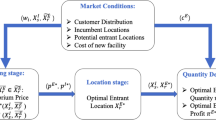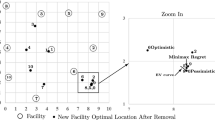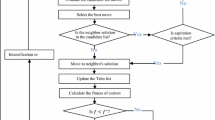Abstract
Competitive facility location models consider two main strategies for increasing the market share captured by a chain subject to a budget constraint. One strategy is the improvement of existing facilities. The second strategy is the construction of new facilities. In this paper we analyse these two strategies as well as the joint strategy which is a combination of the two. All three strategies are formulated as a unified model. The best solution to an individual strategy is a feasible solution to the joint one. Therefore, the joint strategy must yield solutions that are at least as good as the solutions to each of the individual strategies. Based on the results of extensive experiments, we conclude that the increase in market share captured by a chain when the joint strategy is employed can be significantly higher than increases obtained by individual strategies. A branch and bound procedure and a tabu search heuristic are constructed for the solution of the unified model. Both algorithms performed very well on a set of test problems with up to 900 demand points. A total of 62% of the test problems were optimally solved by the branch and bound procedure.
Similar content being viewed by others
References
Beasley JE (1990). OR-library—Distributing test problems by electronic mail. Journal of the Operational Research Society 41 (11): 1069–1072.
Berman O and Krass D (2002). Locating multiple competitive facilities: Spatial interaction models with variable expenditures. Annals of Operations Research 111: 197–225.
Berman O, Drezner T, Drezner Z and Krass D (2009a). Modeling competitive facility location problems: New approaches and results. In: Oskoorouchi M (ed). TutORials in Operations Research. INFORMS: San Diego, CA, pp 156–181.
Berman O, Drezner Z, Krass D and Wesolowsky GO (2009b). The variable radius covering problem. European Journal of Operational Research 196 (2): 516–525.
Berman O, Drezner Z and Krass D (2010). Generalized coverage: New developments in covering location models. Computers and Operations Research 37 (10): 1675–1687.
Christaller W (1966). Central Places in Southern Germany. Prentice-Hall: Englewood Cliffs, NJ.
Current J, Daskin M and Schilling D (2002). Discrete network location models. In: Drezner Z and Hamacher HW (eds) Facility Location: Applications and Theory. Springer-Verlag: Berlin, pp 81–118.
Drezner T (1994). Locating a single new facility among existing, unequally attractive facilities. Journal of Regional Science 34 (2): 237–252.
Drezner T (ed.) (1995). Competitive facility location in the plane. In: Facility Location: A Survey of Applications and Methods. Springer: New York, NY, pp 285–300.
Drezner T and Drezner Z (1996). Competitive facilities: Market share and location with random utility. Journal of Regional Science 36 (1): 1–15.
Drezner T and Drezner Z (1998). Facility location in anticipation of future competition. Location Science 6: 155–173.
Drezner T and Drezner Z (2008). Lost demand in a competitive environment. Journal of the Operational Research Society 59 (3): 362–371.
Drezner T and Drezner Z (2012). Modelling lost demand in competitive facility location. Journal of the Operational Research Society 63 (2): 201–206.
Drezner T, Drezner Z and Kalczynski P (2011). A cover-based competitive location model. Journal of the Operational Research Society 62 (1): 100–113.
Drezner Z, Wesolowsky GO and Drezner T (1998). On the logit approach to competitive facility location. Journal of Regional Science 38 (2): 313–327.
Fernandez J, Pelegrin B, Plastria F and Toth B (2007). Solving a Huff-like competitive location and design model for profit maximization in the plane. European Journal of Operational Research 179 (3): 1274–1287.
Ghosh A and Craig CS (1991). FRANSYS: A franchise location model. Journal of Retailing 67 (4): 212–234.
Glover F (1986). Future paths for integer programming and links to artificial intelligence. Computers and Operations Research 13 (5): 533–549.
Glover F and Laguna M (1997). Tabu Search. Kluwer Academic Publishers: Boston, MA.
Hotelling H (1929). Stability in competition. Economic Journal 39 (153): 41–57.
Huff DL (1964). Defining and estimating a trading area. Journal of Marketing 28 (3): 34–38.
Huff DL (1966). A programmed solution for approximating an optimum retail location. Land Economics 42 (3): 293–303.
Küçükaydin H, Aras N and Atinel IK (2011). Competitive facility location problem with attractiveness adjustment of the follower: A bilevel programming model and its solution. European Journal of Operational Research 208 (3): 206–220.
Leonardi G and Tadei R (1984). Random utility demand models and service location. Regional Science and Urban Economics 14 (3): 399–431.
Losch A (1954). The Economics of Location. Yale University Press: New Haven, CT.
Plastria F (2002). Continuous covering location problems. In: Drezner Z and Hamacher HW (eds). Facility Location: Applications and Theory. Springer-Verlag: Berlin, pp 37–79.
Redondo JL, Fernandez J, Garcia I and Ortigosa PM (2009). Solving the multiple competitive facilities location and design problem on the plane. Evolutionary Computation 17 (1): 21–53.
Reilly WJ (1931). The Law of Retail Gravitation. Knickerbocker Press: New York, NY.
Schilling DA, Vaidyanathan J and Barkhi R (1993). A review of covering problems in facility location. Location Science 1 (1): 25–55.
Stackelberg HV (1934). Marktform und Gleichgewicht. Julius Springer: Vienne.
Author information
Authors and Affiliations
Corresponding author
Appendix
Appendix
A.1. Nonlinear Integer Programming Formulation
To formulate the problem as a nonlinear binary program define the following sets and binary variables:

Also, y
ij
=0 when i∉I
j
. By these definitions r
j
= and q
i
=∑
j=1
p
y
ij
. The nonlinear binary program is:
and q
i
=∑
j=1
p
y
ij
. The nonlinear binary program is:

subject to:




Constraints (A.2) guarantee that at most one distance is selected for each facility. If for some j the sum is equal to 0, facility j is not improved. The right-hand side of constraints (A.3) is r j . Constraints (A.3) guarantee that y ij =0 if d ij >r j . Since the objective function increases if y ij increases, then if constraints (A.3) allow for y ij =1, then y ij =1 in the optimal solution. Constraint (A.4) is the limited budget constraint. Constraints (A.5) require binary variables which reduce the number of y ij variables by requiring that those not in I j are equal to 0. In the objective function (A.1) a special treatment is required for demand points where F i +C i =0. In this case the expression in the objective function (A.1) is w i min {∑ j=1 p y ij , 1} rather than the ratio expression.
Rights and permissions
About this article
Cite this article
Drezner, T., Drezner, Z. & Kalczynski, P. Strategic competitive location: improving existing and establishing new facilities. J Oper Res Soc 63, 1720–1730 (2012). https://doi.org/10.1057/jors.2012.16
Received:
Accepted:
Published:
Issue Date:
DOI: https://doi.org/10.1057/jors.2012.16




